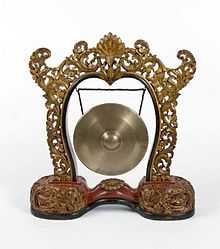Kenong

The kenong is one of the instruments used in the Indonesian gamelan. It is technically a kind of gong, but is placed on its side and is roughly as tall as it is wide. It thus is similar to the bonang, kempyang and ketuk, which are also cradled gongs. Kenongs are generally much larger than any of those, however. Its pitch is actually rather high considering its size; its sound stands out however because of its unique timbre. They are usually played with similar padded sticks to the bonang, except larger. The kenong is sometimes played by the same player as the kempyang and ketuk.
The kenong usually has a specific part in the colotomic structure of the gamelan, marking off parts of a structure smaller than a gongan (the space between each strike of the gong). The interval of each part between strikes of a kenong is called a nongan. In a fast, short structure these can only last a second or so; in a longer gendhing, particularly in a slow irama, they can last several minutes. There are usually two or four nongans in a gongan.
Kenongs are usually in sets of one for each note, although sometimes other notes can be substituted for any missing notes. A full gamelan would include sets for slendro and pelog. The boxes (rancak) for the kenong are usually for one or two; these are then put in a line or curve surrounding the player. There are generally more of them than there are kempuls, as all gamelan structures require kenong but not necessarily kempul.
External links
| ||||||||||||||||||||||||||||||||||||||

